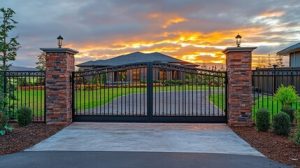
New regulations mandate that non-residential projects consider embodied carbon, encouraging innovation in concrete solutions. Emerging technologies, such as carbon-capturing concrete that absorbs CO2 during curing, reduce emissions without compromising performance.
Consultation and accurate estimates empower clients to make confident sustainability choices. They know the upfront costs are offset by long-term savings in energy and maintenance. Learn more about sustainable construction solutions at https://www.gkconstructionsolutions.com/.
Durability
Concrete is used worldwide to build a vast array of structures, from houses and office buildings to airports, highways, and railway systems. Its durability, strength, and relatively low cost make it an ideal construction material. Unlike wood, which can rot, and steel, which can rust, concrete lasts for decades, even centuries, with minimal maintenance.
Concrete’s natural durability helps to reduce a building’s environmental impact throughout its life cycle. This is because it minimizes the need for frequent repairs and replacement, thereby cutting embodied carbon in both its production and its lifetime use. In addition, a structure built with durable materials can avoid damage from extreme weather conditions and other environmental impacts, such as chemical exposure, that could shorten its lifespan.
The durability of concrete is due to its high compressive strength and relative resistance to tensile stress. Concrete is typically reinforced with a material strong in tension, such as steel, to increase its tensile strength and prevent cracking during structural expansion or contraction. This reinforcement significantly increases the structural integrity of a concrete structure, increasing its longevity and lowering its energy consumption.
When evaluating the sustainability of commercial concrete services, look for those that prioritize eco-friendly practices. This includes embracing sustainable cement, using recycled aggregates, and repurposing old concrete for use as road base or in other applications. A commitment to promoting the circular economy also extends to innovative solutions such as recycled fiber reinforcement, which uses waste materials to enhance concrete’s performance and durability while diverting construction and demolition waste from landfills.
Choosing a concrete service with an established track record of sustainability can help you avoid costly mistakes that could taint your project’s reputation. In addition, working with a trusted partner can help you achieve your sustainable goals while staying on budget and reducing construction time.
Durable, energy efficient, and recyclable, concrete is the cornerstone of sustainable commercial construction. By incorporating these principles into projects, you can reduce your project’s environmental footprint and boost its return on investment.
Local Availability
Concrete’s ability to absorb and retain heat enables it to cut peak energy demand in commercial buildings, helping to reduce utility costs. The material is also fire-resistant and offers additional protection for occupants.
While it may seem counterintuitive to use a high-performance material that requires more upfront investment, eco-friendly materials tend to cost less in the long run — especially when factoring in maintenance costs. Moreover, when contractors partner with local suppliers that prioritize sustainability, they can achieve significant savings in materials and labor costs.
With a range of options to choose from, builders can find the right mix for their project. Options range from crushed urban demolition debris to innovative products like glasscrete. Low-energy mixing technologies and steam and controlled curing methods further reduce embodied carbon in the concrete, as well as the energy needed to produce it.
In addition, modern sustainable concrete mixes are formulated to meet structural, durability and aesthetic requirements without compromising quality or performance. This enables concrete manufacturers to use recycled aggregates and alternative binders, while reducing the overall environmental impact of their products.
For construction professionals, balancing client needs, regulatory mandates and sustainability targets is challenging. A focus on concrete solutions that offer superior performance and durability, such as self-healing concrete, can help ensure projects are delivered on time and within budget while meeting sustainability goals.
Using sustainable concrete is one of the best ways to reduce CO2 emissions. While a large share of concrete’s impact comes from the energy used to produce it (about 0.8 pound of CO2 per cubic yard), this can be minimised by limiting cement content and utilising SCMs and recycled materials where possible. Specification changes such as replacing minimum cement requirements with compressive strength requirements can also significantly reduce carbon output. These approaches can be coupled with a passive solar design to further optimise energy efficiency.
Recyclability
Concrete is a highly recyclable material, as it can be reused for new construction or turned into other products. Its durability and long lifespan also make it a good choice for reuse after structures have reached the end of their service life.
Recycling concrete reduces the need for virgin aggregates, thus saving on the use of natural resources. However, incorporating recycled concrete into a project requires thorough testing to ensure the quality and safety of the finished product.
Recycled materials can help meet the sustainability goals of a commercial building project without impacting the design or cost. Recycled concrete, for example, can be used as an alternative to conventional aggregates in standard mixes to achieve the same structural performance. This approach lowers costs and reduces the waste generated by demolition and construction projects (Titirici et al, 2022).
The proportions of the ingredients in concrete are adjusted to meet specific requirements for the hardened state. For example, in cold weather, the concrete mix needs to be made with higher proportions of coarse aggregates to have enough strength to resist freezing. The mix should also include more water to prevent cracking due to shrinkage. Additionally, concrete is kept damp during the curing phase to slow down the loss of strength, as the low temperatures adversely affect the chemical reactions required for hydration.
In addition to increasing the recyclability of concrete, sustainable commercial construction should incorporate materials that are biodegradable or have very little environmental impact (Krishnan et al, 2021). Nonrenewable materials, like concrete, pollute the environment during the construction process and generate microplastics in oceans after disposal. Using sustainable materials that are biodegradable or have no environmental impact can reduce this pollution, as they decompose rapidly into useful products rather than polluting the environment for decades and centuries.
Concrete is an essential part of the built environment and must be designed, fabricated and constructed with the sustainability goal in mind. The development of innovative construction techniques and materials that minimize the negative impacts of concrete will help promote sustainability in the construction industry and the world at large.
Energy Efficiency
Concrete is made by combining coarse aggregates like gravel or crushed stones with a finer material, usually sand. Then cement is mixed in to form a thick paste that hardens under the influence of water. The concrete mixture can then be poured into different shapes and structures, such as foundations or buildings. Concrete is also used in road construction and to make dams. Its durability, strength and relative low cost make it one of the most common building materials worldwide.
The production of concrete contributes to climate change, with energy use, raw material processing and transportation causing the largest share of emissions. However, a single tonne of concrete generates only small amounts of greenhouse gases. Nevertheless, the industry is working to lower its carbon intensity. For instance, new technologies are being developed to substitute part of the limestone that is normally burned in cement kilns with gypsum, which has significantly lower CO2 emissions. In addition, some companies are experimenting with lignocellulosic materials such as hemp and mycelium to add tensile strength without compromising concrete’s other desirable properties.
In addition, modern concrete structures are incorporating insulating concrete and thermal mass to improve energy efficiency. Insulating concrete reduces air leakage, which is a significant contributor to heat loss. Meanwhile, the thermal mass of concrete walls absorbs and stores energy throughout the day, helping to stabilize indoor temperatures.
When used in buildings, concrete has the advantage of being able to withstand both lateral and axial stress. The material is also fire resistant and has a high resistance to corrosion.
While concrete is durable, it can be prone to cracking and spalling over time. This can be mitigated by proper installation and maintenance procedures.
As the world’s most abundant and versatile construction material, concrete is a key component of sustainable commercial construction projects. Its durability, strength and relative low price ensure that it will continue to play a vital role in construction of commercial buildings and infrastructure worldwide. The sustainable qualities of the material are reinforced by the way in which it is manufactured, using recycled and reclaimed materials whenever possible.



